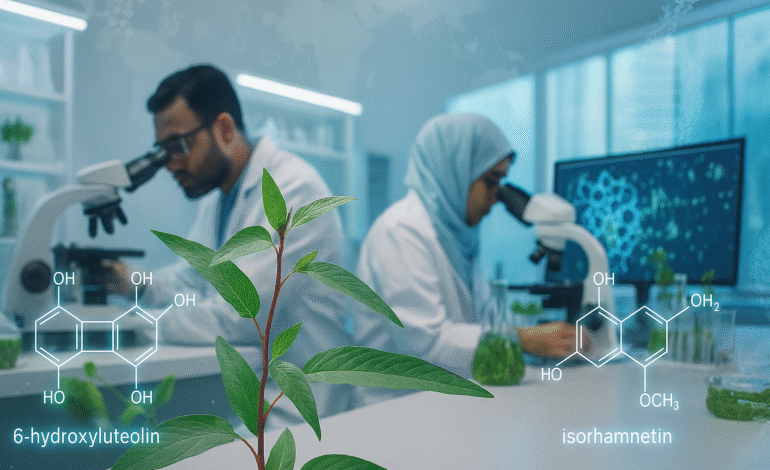Bangladesh Young Scientists Discover Anti-Cancer Compounds In Local Plant

Bangladesh Young Scientists Discover Anti-Cancer Compounds In a Local Plant
Bangladesh scientists have identified promising compounds in the common plant Persicaria hydropiper, locally known as Bishkatali, that would help treat Liver cancer: Hepatocellular carcinoma (HCC). This breakthrough highlights the global potential of under-studied medicinal plants and underscores how biodiversity in Bangladesh can contribute to the global fight against cancer.
What the Research Found
A team of Bangladeshi students and researchers from institutions including North South University, Jahangirnagar University, Primeasia University and India’s Katwa College. The lead researcher, S. Faisal Ahmed, guided the investigation.
In their research, the team isolated two compounds from Persicaria hydropiper : 6-hydroxyluteolin and isorhamnetin.
These compounds were found via computational simulations to bind to and inhibit the VEGFR-2 protein — a receptor involved in tumour angiogenesis (the process by which tumours form new blood vessels to sustain growth).
Additionally, the study identified a human microRNA (“hsa-miR-17-3p”) as a gene-silencing agent that may suppress the gene responsible for VEGFR-2 production — thereby offering a dual mechanism of action (natural compounds plus gene-silencing).
In silico simulations showed the compounds had favourable safety and stability profiles, and in some respects outperformed the current anti-cancer drug Sunitinib in simulation models — with predicted low toxicity and good tolerance.
The researchers emphasised that while results are promising, they remain at the computational/simulation stage and must be followed up by laboratory (in vitro) and animal/human (in vivo) studies.
Why This Discovery Matters Globally
Bridging Traditional Knowledge and Modern Science
Medicinal plants have long been a rich source of therapeutic agents — estimates suggest around 28 % of new chemical drugs originate from natural sources. Bangladesh, with its diverse flora and traditional herbal knowledge, is part of this global treasure-chest. The discovery of anti-cancer compounds in a widely-available local plant illustrates how indigenous botanical resources can yield globally relevant health breakthroughs.
Addressing a Worldwide Health Challenge
Hepatocellular carcinoma (HCC) accounts for more than 80 % of liver-cancer cases worldwide and remains difficult to treat effectively. Finding novel agents that can inhibit tumour growth via new pathways (e.g., angiogenesis inhibition by natural compounds) is a major objective in cancer research globally.
Cost-Effective and Accessible Therapies
Natural-compound-based drugs may offer more affordable and locally-adaptable alternatives, especially in low- and middle-income countries. The fact that the plant is abundant in Bangladesh and throughout the Indian subcontinent increases its accessibility. That opens possibilities for wider application in global health contexts where cost is a barrier.
A Model for Future Drug Discovery
The methodology used — combining in silico computational docking, gene-silencing microRNA identification and traditional plant screening — exemplifies a modern drug-discovery pipeline that may be replicated elsewhere. As more scientists explore regional flora, other “hidden gem” plants could emerge as therapeutic leads.
The Science Behind the Plant and Compounds
What Is Persicaria hydropiper (Bishkatali)?
Persicaria hydropiper is a common wild plant found in Bangladesh and other parts of the Indian subcontinent. It has long been used in traditional agriculture as a pest-repellent and crop-preservative by peasants in Bengal. The plant’s prior use in folk practice planted the seed (pun intended) for deeper phytochemical exploration.
How Do the Identified Compounds Work?
6-Hydroxyluteolin and Isorhamnetin are flavonoid-type compounds (a class of plant-derived secondary metabolites). The research showed they may bind to VEGFR-2, blocking angiogenesis — depriving tumours of blood-supply and thus suppressing growth.
The microRNA hsa-miR-17-3p complements this by silencing gene expression responsible for VEGFR-2 production. Thus the combination targets both the receptor and its gene-factory.
Simulation studies suggested favourable pharmacokinetic and safety profiles; though again, real-world lab/clinical validation is still pending.
Challenges & Next Steps
While the discovery is promising, several hurdles remain before the compounds can become a usable therapy:
In vitro and in vivo validation: Results thus far are computer-based; cell-line studies, animal trials and ultimately human clinical trials are required. Without them, clinical efficacy remains theoretical.
Extraction & scaling: Stabilising compound extraction, maintaining quality, ensuring reproducibility and addressing formulation issues are major practical steps.
Safety and regulation: Even though simulations show favourable toxicity profiles, real-world safety in humans must be established.
Intellectual property & benefit-sharing: As plants and knowledge originate in Bangladesh, equitable benefit-sharing frameworks for local communities, researchers and international collaborators must be considered.
Global market entry: Steps from discovery to drug-approved therapy are long, expensive and global. Partnerships, funding and regulatory support will be key.
Wider Implications for Bangladesh and the World
For Bangladesh:
This research underscores the country’s capability to participate meaningfully in global biomedical research.
It may stimulate investment into local biotech, plant-science infrastructure and capacity-building.
The abundant presence of the plant offers potential economic opportunity — raw-material cultivation, research parks, biotech spin-offs.
For the world:
It highlights how global drug-discovery efforts can benefit from inclusive, diverse botanical sourcing. Under-represented regions like South Asia may hold untapped therapeutic leads.
It supports the paradigm of “nature-based solutions” in medicine, which aligns with sustainable, accessible healthcare goals.
It offers hope for new anti-cancer therapies that may complement existing treatments, especially in resource-constrained settings.
Framing the Discovery in a Global Landscape
In the broader context of medicinal-plant research:
Around 80 % of the world’s population still relies on traditional herbal medicines for primary healthcare.
Yet only a fraction of plant species have been scientifically evaluated for therapeutic compounds.
The move toward computer-modelled drug discovery, coupled with gene-silencing technologies (like microRNAs), is accelerating the pace of new therapeutic development. The Bangladesh study is a clear example.
As global health challenges (such as cancer, antimicrobial resistance, chronic diseases) mount, plant-derived compounds present promising, broadly applicable solutions.
Conclusion
The discovery of anti-cancer compounds in Persicaria hydropiper (Bishkatali) is more than a local success story — it is a testament to the global potential of botanical research, inclusive science and sustainable medicine. For Bangladesh, it marks a step into the global biomedical spotlight. For the world, it provides hope for new ways to tackle diseases like hepatocellular carcinoma.
As the research progresses from computer simulations to lab testing, from bench to bedside, the promise is clear: a modest wild plant could help unlock therapies for one of the world’s most challenging cancers. In doing so, it reminds us that nature still holds secrets yet to be discovered — and that global health may depend as much on local flora as on high-tech labs.







